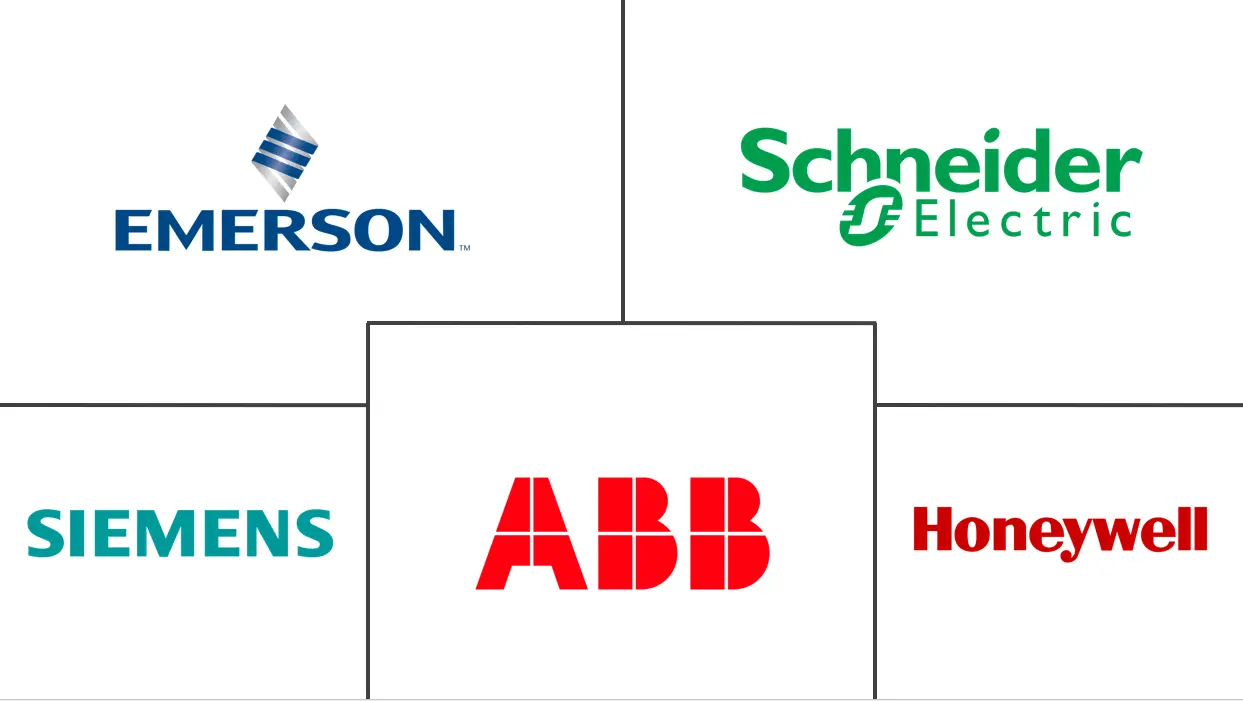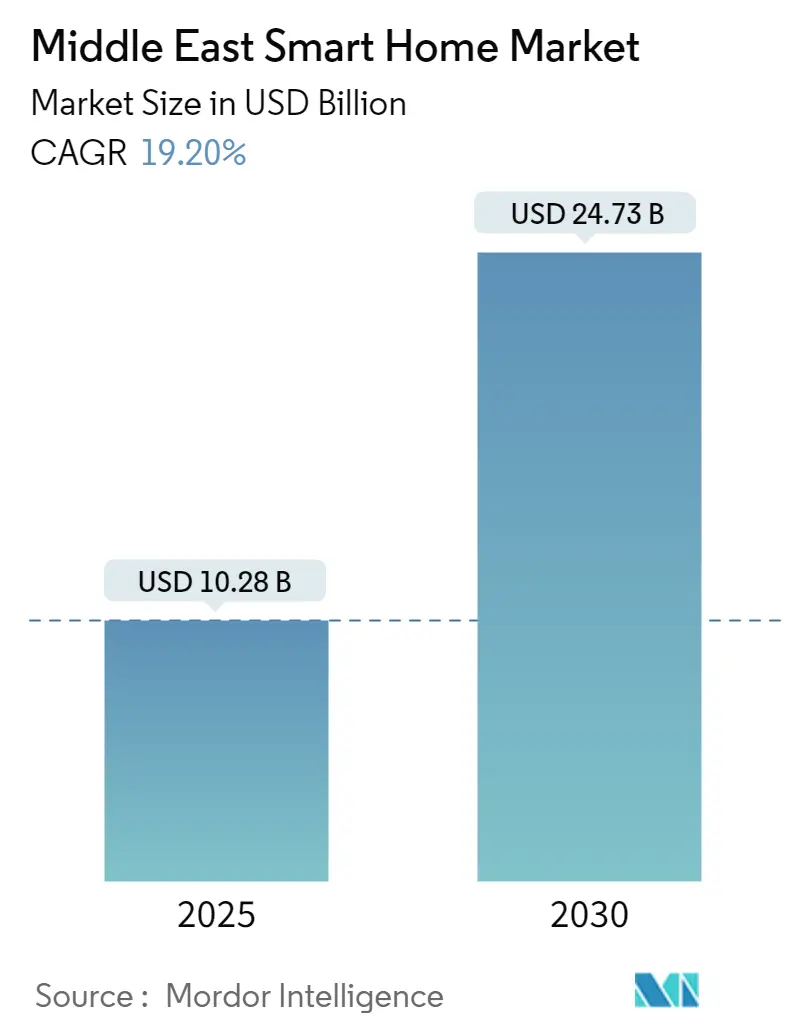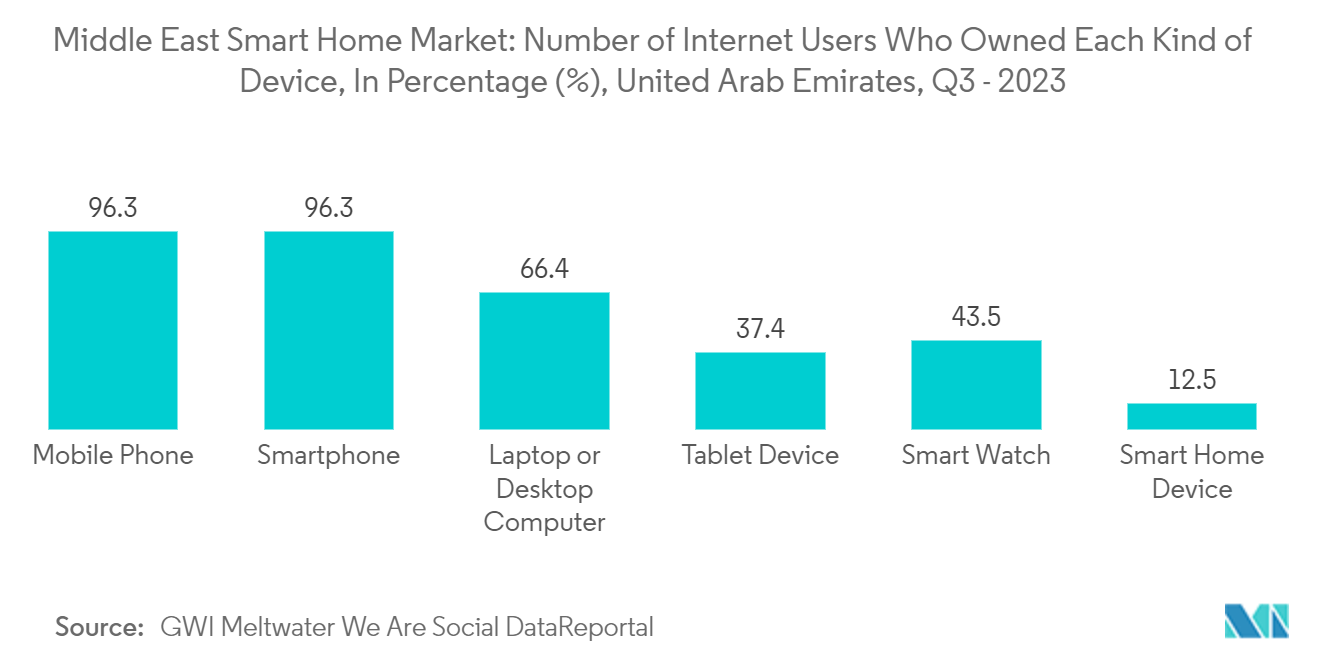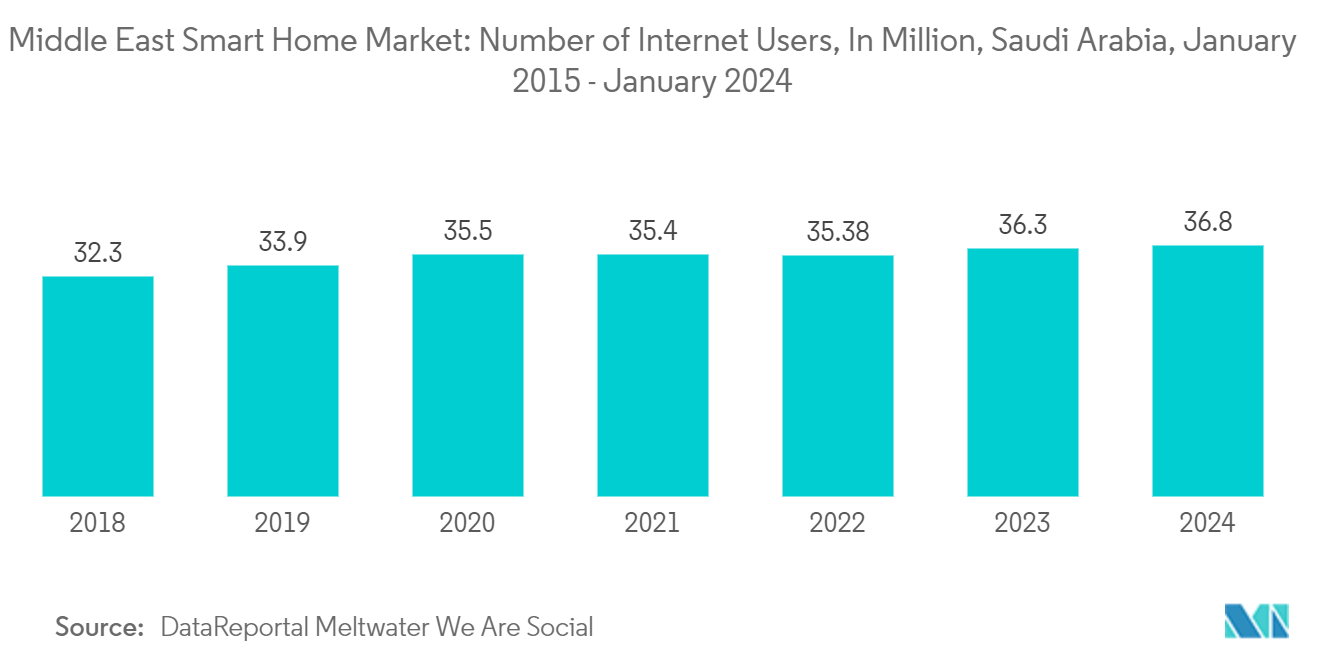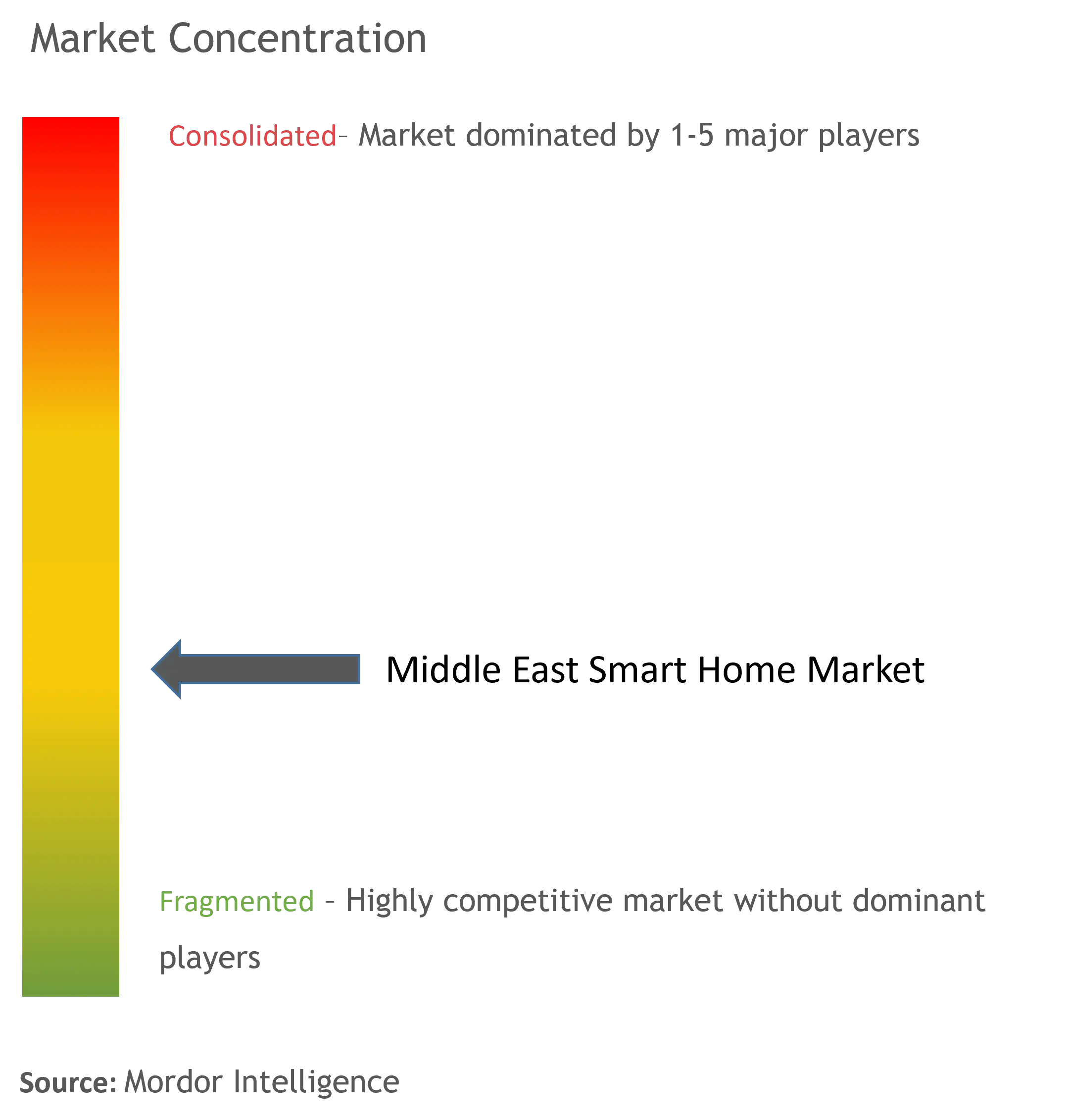Middle East Smart Home Market Analysis
The Middle East Smart Home Market size is estimated at USD 10.28 billion in 2025, and is expected to reach USD 24.73 billion by 2030, at a CAGR of 19.2% during the forecast period (2025-2030).
- The smart home market in the Middle East is experiencing a significant growth trajectory, driven by increasing disposable incomes and a tech-savvy population. Consumer demand in the region is gravitating towards enhanced security systems, energy management solutions, and smart entertainment devices. The high penetration of smartphones and internet connectivity in the region is a pivotal factor enabling the seamless operation and control of smart home devices. According to data published by GSMA, the smartphone penetration rate in the Middle East is more than 76%.
- Moreover, the affluent consumer base is increasingly inclined toward adopting cutting-edge home automation systems that offer convenience, security, and energy efficiency. As a result, smart thermostats, lighting controls, and automated security systems are seeing robust demand.
- The market is also characterized by global tech players like Apple, Amazon, and Google, alongside regional players who tailor their offerings to meet local preferences. Additionally, there is a growing ecosystem of startups that are innovating with region-specific smart home solutions, contributing to market diversity and competition.
- The technology is becoming prominent is countries such as United Arab Emirates and Kingdom of Saudi Arabia due to its affordability because of high income levels. Smart home voice activated devices such as Alexa have become popular due to ease of use in terms of controlling lighting, air conditioners, cameras and TVs. The rapid adoption of smart home technology has streamlined everyday tasks for the tech savvy customers.
- According to a report published by Amazon in January 2024, customers in Middle East are widely engaged for the second year in a row with 14 interactions a day per customer.
- In 2023, Alexa saw a 40 percent increase in monthly active users in the region, with Alexa interactions growing by 30 percent compared to 2022. Throughout the year, Alexa switched lights on and off over 24 million times in Saudi Arabia and the UAE alone, indicating a significant surge in engagement. As the region embraces digital transformation, integrating smart home technologies is poised to become a standard feature of modern living.
Middle East Smart Home Market Trends
United Arab Emirates in Experiencing Significant Demand
- The smart home market in the United Arab Emirates is undergoing a remarkable evolution, marked by rapid growth and dynamic trends. Driven by increasing internet penetration, rising consumer demand for connected devices, and disposable income, the UAE's smart home market is becoming one of the most advanced in the Middle East. One of the key factors propelling the growth is the widespread internet and smartphone penetration rates in the region, which facilitates the seamless integration of smart home devices.
- According to data published by Worldbank, 100% of UAE's population is equipped with an internet connection and more than 18 million active mobile subscription based on data provided by Telecommunications Regulatory Authority (UAE). This connectivity allows homeowners to control and monitor their home devices remotely through smartphones and other devices, enhancing convenience and security.
- The increasing adoption of 5g further amplies this trends, providing faster and more reliable connection. According to a survey conducted by Ericsson, 57 percent of users in UAE are very happy with their 5G network performance, which is among the highest shares globally. According to data published by DataReportal, 96.3% of the internet uses in UAE owned a smarphone, 37.4 % of the internet users owned a tablet, and 12.5% owned a Smart Home Device, as per survey conducted in 3rd quarter of 2023.
- The local ecosystem is also booming with domestic players stepping up for proving smart home solutions with collaborations with international players. For instance, in April 2024, Aqara, a leading provider of smart home solutions, announced a collaboration with e&UAE, the telecom arm of e&. This partnership introduces a wide range of Aqara devices to the local market, including smart home hubs, sensors, light switches, retrofit roller shade controllers, and wireless switches.
- Additionally, a Starter Kit is available for those seeking a comprehensive smart home experience. To simplify adoption, a hassle-free installation service is included with the bundle, allowing more consumers to enjoy the benefits of smart home technology without the complexity. This collaboration represents a significant step towards making smart living accessible and convenient for UAE residents, aligning with the shared vision of advancing the digital future for homes. Looking ahead, Aqara and e&UAE are excited to expand their partnership to include new and innovative products, solutions, and smart home platforms for enhanced experiences.
Comfort and Lighting Segment is Experiencing Strong Demand
- Comfort and Lighting segment is experiencing is driven by increasing consumer demand for convenience, energy efficiency, and enhanced living environments. As disposable incomes rise, there is a growing appretite for smart home solutions that can seamlessly integrate into daily life, offering both luxury and practical benefits.
- Due to the regions extreme climatic conditions, smart climate control systems are becoming essential. These systems enable precise regulation of indoor temperatures, reducing energy consumption and costs while maintaining optimal comfort. For instance, smart thermostats and air conditioning units that can be controlled remotely. Smart lighting solutions is also witnessing robust growth with consumers that are drawn to flexibility and energy efficiency. These systems allows users to customize lighting settings to match their moods, activities, or the time of the day, contributing to both the aesthetic appeal and functional efficiency.
- For instance, in Saudi Arabia and the United Arab Emirates, the integration of smart AI assistants like Alexa into homes has surged, with six million devices enhancing daily routines. Lighting, air conditioning, TVs, and cameras are among the most popular categories controlled by Alexa, reflecting a shift towards voice-enabled home automation. In 2023, nearly 130 million smart home actions were initiated, accompanied by over 100 million requests for music, Quran, and podcasts. This growth is evidenced by a 50% year-on-year increase in smart home customers and a 90% increase in connected devices. Amazon's investment in local customization ensures Alexa caters to unique regional needs, fostering excitement for AI advancement.
- Saudi Arabia, which is one of the biggest and fast growing market in the Middle East has approximately 36.8 million internet users as of January 2024, based on data provided by DataReportal and Meltwater. In comparison, its population is approximately 37.4 million as of 2024, which showcases the country's huge internet penetration rate. Similar characteristics is demonstrated by other neighbouring Middle Eastern countries, painting a positive picture for the growth of market.
Middle East Smart Home Industry Overview
The smart home market in the Middle East is fragmented, driven by high disposable incomes and tech-savvy consumers who prefer a range of options. Major players such as Google and Amazon compete with other international and regional companies by offering diverse smart home devices and integrated systems tailored to local preferences. The competition is intensified by the fast pace of technological advancements and the growing consumer demand for innovative, cost-effective, and energy-efficient solutions.
- March 2024 - Samsung Electronics has seamlessly integrated ABB-free@home® automation into its SmartThings platform, offering residents a single, comprehensive app for managing diverse appliances and devices from various manufacturers. This partnership creates a world-class automation platform, simplifying home management and eliminating application overload. ABB-free@home now interacts with all SmartThings partner solutions, providing remote access and individualized control. Property managers in rental and multi-dwelling units can also benefit from enhanced innovation opportunities in automation, energy management, and service systems.
- March 2024 - Schneider Electric unveiled the upgraded Back-UPS BE Series – 900 & 1050 VA, catering to remote work and smart home needs. With increased power capacity, they ensure uninterrupted connectivity for critical devices. The modern design optimizes space with stackable surfaces. Users benefit from enhanced convenience with USB charging ports and user-friendly interface signaling UPS status. Moreover, the series prioritizes sustainability, meeting stringent energy efficiency standards. The inclusion of PowerChute Serial Shutdown software aids in utility bill savings.
Middle East Smart Home Market Leaders
-
ABB Ltd
-
Schneider Electric SE
-
Honeywell International Inc.
-
Emerson Electric Co.
-
Siemens AG
- *Disclaimer: Major Players sorted in no particular order
Middle East Smart Home Market News
- January 2024 - Universal Electronics Inc. introduced the UEI Butler Smart Home Control Hubs at CES. These hubs offer seamless integration with QuickSet Cloud, facilitating Discovery, Control, and Interaction across various connected devices for smarter living. With pre-integrated Zigbee sensors, Wi-Fi or Ethernet configurations, and matter-bridging capability, they enable tailored experiences for energy management, climate control, and smart lighting. Featuring Matter Controller and multi-admin capabilities, alongside nevo.ai virtual agent support, they ensure personalized, hassle-free operation.
- December 2023 - Aqara and iot squared have inked an MoU, targeting ICT and IoT advancements in Saudi Arabia, in line with Vision 2030. Aqara, known for its smart home solutions, and iot squared, a collaboration between stc Group and Saudi Arabia's Public Investment Fund, will jointly provide IoT products and services to Saudi consumers. The aim is to develop tailored smart home solutions leveraging Aqara's platform and iot squared's industry expertise. The collaboration seeks to accelerate IoT adoption, enhancing technological innovation and quality of life in Saudi Arabia.
Middle East Smart Home Industry Segmentation
A smart home uses internet-connected devices to enable remote management and automation of household systems such as lighting, heating, security, and entertainment. These devices, which can be controlled via smartphones, tablets, or voice assistants, communicate with each other to optimize energy usage, enhance convenience, and improve security. The integration of IoT technology allows for seamless interaction and personalized control, making everyday tasks more efficient and convenient.
The Middle East Smart Home Market is Segmented by Product (Comfort and Lighting, Control and Connectivity, Energy Management, Home Entertainment, and Security) and Country (Saudi Arabia, United Arab Emirates, Qatar, and the Rest of the Middle East). The Report Offers Market Size and Forecast for all the Above Segments in Value (USD).
| By Product | Comfort and Lighting |
| Control and Connectivity | |
| Energy Management | |
| Home Entertainment | |
| Security | |
| By Country*** | Saudi Arabia |
| United Arab Emirates | |
| Qatar | |
| Egypt | |
| Turkey |
Middle East Smart Home Market Research FAQs
How big is the Middle East Smart Home Market?
The Middle East Smart Home Market size is expected to reach USD 10.28 billion in 2025 and grow at a CAGR of 19.20% to reach USD 24.73 billion by 2030.
What is the current Middle East Smart Home Market size?
In 2025, the Middle East Smart Home Market size is expected to reach USD 10.28 billion.
Who are the key players in Middle East Smart Home Market?
ABB Ltd, Schneider Electric SE, Honeywell International Inc., Emerson Electric Co. and Siemens AG are the major companies operating in the Middle East Smart Home Market.
What years does this Middle East Smart Home Market cover, and what was the market size in 2024?
In 2024, the Middle East Smart Home Market size was estimated at USD 8.31 billion. The report covers the Middle East Smart Home Market historical market size for years: 2019, 2020, 2021, 2022, 2023 and 2024. The report also forecasts the Middle East Smart Home Market size for years: 2025, 2026, 2027, 2028, 2029 and 2030.
Middle East Smart Home Industry Report
Statistics for the 2025 Middle East Smart Home market share, size and revenue growth rate, created by Mordor Intelligence™ Industry Reports. Middle East Smart Home analysis includes a market forecast outlook for 2025 to 2030 and historical overview. Get a sample of this industry analysis as a free report PDF download.

